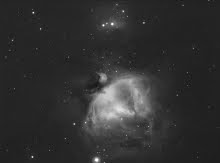Transparency
Transparency is the clarity of the atmosphere which is affected by clouds, moisture, dust and other particles. Only the brightest stars can be seen through thin cirrus clouds. Hazy skies absorbe more light than clear skies making fainter objects harder to see and reducing contrast on brighter objects. Ideal conditions are inky black skies.
Sky illumination
General sky brightening caused by the Moon, aurorae, natural glow and light pollution greatly affect transparency. While not a big problem for bright stars and planets bright skies reduce the contrast of nebulae and galaxies. DSO imaging should be done in moonless nights far from light polution but planetary imaging can be done in more polluted areas.
Seeing
Seeing conditions refers to the stability of the atmosphere and directly affects the amount of fine details which can be imaged in extended objects like nebulae and galaxies. The air in our atmosphere acts like a lens which bends and distorts the light. The amount of bending depends on the air density. Varying temperature layers in our atmosphere have different densities and therefore bend light differently. Light from the same object arrive slightly displaced creating an imperfect (smeared) image. These atmospheric condistions vary from time to time. Under good seeing conditions fine detail is visible on brighter planets like Jupiter and stars are pinpoints. Under poor seeing conditions images are blurred and stars appear as blobs. See also here for more information.
The seeing can be measured by looking to a 2-3 magnitude star near the zenith at a power of about 30-40X per inch diameter ( 300-400x for a 10 inch telescope ). From the look of the diffraction pattern an estimation for the seeing can be done on a V-I scale.

The seeing can be rated through amateur telescopes with the following guidance :
| - | V | : | Perfect motionless diffraction pattern |
| - | IV | : | Light undulations across diffraction rings |
| - | III | : | Central disc deformations. Broken diffraction rings |
| - | II | : | Important deformations in the central disc. Missing or partly missing diffraction rings |
| - | I | : | Boiling image without any sign of diffraction pattern. |
Of course, the diffraction pattern diameter is related to the aperture of the telescope. The diffraction pattern of a 4 inch telescope is twice as large as for an 8 inch instrument. So the seeing rating with this method will depend of the diameter of the telescope. An astro-amateur rating the seeing at 4/5 with a 6 inch telescope will certainly appear as a 3/5 with a 12-14 inch optical instrument. So it is important to understand or be aware of this difference.








